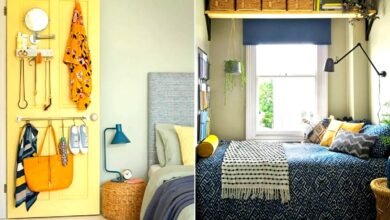Decorating Mistakes to Avoid: 2025 Edition
In this comprehensive guide, we’ll explore the top decorating mistakes to avoid in 2025, offering expert advice to help you craft a space that’s both stylish and practical.

Creating a beautiful, functional, and timeless home interior requires careful planning and a keen eye for design. However, even the most enthusiastic homeowners can fall into common traps that compromise their vision. In this comprehensive guide, we’ll explore the top decorating mistakes to avoid in 2025, offering expert advice to help you craft a space that’s both stylish and practical. From outdated trends to functional oversights, these tips will ensure your home reflects modern aesthetics while maintaining comfort and utility. Let’s dive into the key decorating mistakes and how to sidestep them for a flawless interior.
1. Ignoring the Importance of a Cohesive Color Palette
One of the most frequent decorating mistakes is neglecting to establish a cohesive color palette. A haphazard mix of colors can make a room feel chaotic and disjointed. In 2025, interior design trends emphasize harmonious color schemes that create a sense of flow throughout the home.
Why It’s a Problem
Without a unified color palette, your space may lack visual coherence. Clashing hues or overly bold contrasts can overwhelm the senses, making rooms feel smaller or less inviting. For instance, pairing neon accents with muted neutrals without a clear strategy can disrupt the balance.
How to Avoid It
- Choose a Core Palette: Select 2–3 primary colors and 1–2 accent shades. In 2025, earthy tones like terracotta, sage green, and warm beige are trending, paired with pops of bold colors like mustard yellow or deep navy.
- Use the 60-30-10 Rule: Allocate 60% of the room to a dominant color (walls, large furniture), 30% to a secondary color (rugs, curtains), and 10% to accents (throw pillows, artwork).
- Test Before Committing: Use paint samples or digital design tools to visualize how colors work together in your space.
By planning your color scheme thoughtfully, you’ll avoid one of the most common decorating mistakes and create a polished, inviting atmosphere.
2. Overloading Rooms with Furniture
Another prevalent decorating mistake is overcrowding a space with too much furniture. While it’s tempting to fill every corner with pieces you love, this approach can make rooms feel cramped and hinder functionality.
Why It’s a Problem
Excess furniture disrupts the flow of a room, making it difficult to move around comfortably. It can also make spaces appear smaller and less organized. In 2025, minimalist and multifunctional furniture designs are gaining traction, emphasizing open, airy layouts.
How to Avoid It
- Measure Your Space: Before purchasing furniture, measure your room’s dimensions to ensure pieces fit proportionally.
- Prioritize Functionality: Opt for multifunctional furniture, such as ottomans with storage or extendable dining tables, to maximize space.
- Leave Breathing Room: Follow the “less is more” philosophy by allowing empty space around furniture to create a sense of openness.
Avoiding this decorating mistake will help you maintain a balanced, clutter-free environment that feels spacious and welcoming.
3. Neglecting Proper Lighting
Lighting is a critical element of interior design, yet it’s often overlooked, leading to one of the biggest decorating mistakes. Poor lighting can make a room feel uninviting, dim, or overly harsh, detracting from its overall appeal.
Why It’s a Problem
Inadequate or improper lighting can affect a room’s mood and functionality. For example, relying solely on overhead lights can create harsh shadows, while insufficient lighting can make tasks like reading or cooking difficult. In 2025, layered lighting is a key trend, blending ambient, task, and accent lighting for a balanced effect.
How to Avoid It
- Layer Your Lighting: Combine ambient (general), task (focused), and accent (decorative) lighting. For instance, use a chandelier for ambient light, table lamps for task lighting, and wall sconces for accents.
- Incorporate Smart Lighting: Smart bulbs and dimmable fixtures, popular in 2025, allow you to adjust lighting based on the time of day or activity.
- Consider Natural Light: Maximize natural light with sheer curtains or strategically placed mirrors to reflect sunlight.
By addressing lighting early in your design process, you’ll steer clear of this decorating mistake and create a warm, functional space.
4. Following Trends Blindly
Chasing fleeting trends without considering your personal style is a classic decorating mistake. While it’s fun to incorporate trendy elements, overdoing it can make your home feel dated quickly.
Why It’s a Problem
Trends come and go, and what’s popular in 2025 may look outdated by 2027. Overly trendy decor, like overly bold patterns or niche color schemes, can also clash with your home’s architecture or your personal taste, leading to a space that feels inauthentic.
How to Avoid It
- Balance Trends with Timeless Pieces: Pair trendy items, like a velvet accent chair, with classic pieces, such as a neutral sofa or wooden coffee table.
- Focus on Your Style: Choose decor that resonates with your personality and lifestyle, ensuring longevity and satisfaction.
- Incorporate Trends Sparingly: Use trendy elements in small doses, such as throw pillows or artwork, which are easy to update.
By blending trends with timeless design, you’ll avoid this decorating mistake and create a space that feels both current and enduring.
5. Ignoring Scale and Proportion
Failing to consider scale and proportion is a subtle but impactful decorating mistake. Furniture or decor that’s too large or too small for a space can disrupt its harmony.
Why It’s a Problem
Oversized furniture in a small room can make it feel cramped, while tiny pieces in a large space can look out of place. For example, a massive sectional sofa in a compact living room can overwhelm the space, making it feel claustrophobic.
How to Avoid It
- Measure Furniture Against Room Size: Ensure furniture fits the room’s dimensions. A general rule is to leave at least 18 inches of walking space around major pieces.
- Balance Large and Small Elements: Pair a large sofa with smaller side tables or a petite chandelier with a substantial dining table.
- Use Visual Tricks: Mirrors or vertical decor can make small spaces feel larger, while low-profile furniture can balance high ceilings.
Paying attention to scale and proportion will help you avoid this decorating mistake and achieve a cohesive, visually appealing design.
6. Overlooking Texture and Material Variety
A common decorating mistake is focusing solely on color and furniture while neglecting texture and material variety. A room with uniform textures can feel flat and uninspiring.
Why It’s a Problem
Without varied textures, a space lacks depth and visual interest. For instance, a room with only smooth surfaces, like glass and polished wood, may feel cold and sterile. In 2025, tactile materials like bouclé, rattan, and reclaimed wood are trending for their warmth and character.
How to Avoid It
- Mix Textures: Combine soft textures (rugs, throws) with hard surfaces (wood, metal) and organic materials (plants, woven baskets).
- Incorporate Natural Elements: Use materials like stone, linen, or leather to add warmth and authenticity.
- Layer Thoughtfully: Add textured throw pillows, a chunky knit blanket, or a woven wall hanging to create depth.
By embracing texture variety, you’ll avoid this decorating mistake and create a rich, inviting space.
7. Forgetting About Functionality
Prioritizing aesthetics over functionality is a major decorating mistake that can render a space impractical. A beautiful room is only successful if it meets your daily needs.
Why It’s a Problem
A room that looks stunning but doesn’t serve its intended purpose can become frustrating. For example, a stylish but uncomfortable sofa or a dining table with insufficient seating can disrupt your lifestyle.
How to Avoid It
- Define the Room’s Purpose: Before decorating, consider how the space will be used (e.g., entertaining, relaxing, working).
- Choose Practical Furniture: Opt for durable, comfortable pieces that suit your lifestyle, like stain-resistant fabrics for families with kids.
- Plan for Storage: Incorporate hidden storage solutions, such as built-in shelves or under-bed storage, to keep clutter at bay.
Balancing form and function will help you avoid this decorating mistake and create a space that’s both beautiful and livable.
8. Cluttering with Too Many Accessories
Over-accessorizing is a decorating mistake that can make a room feel chaotic and cluttered. While accessories add personality, too many can overwhelm the space.
Why It’s a Problem
Excessive decor, like too many throw pillows, wall art, or knickknacks, can distract from the room’s focal points and make it feel disorganized. In 2025, curated, intentional decor is a key trend.
How to Avoid It
- Edit Ruthlessly: Choose a few meaningful accessories, like a statement vase or a single bold artwork, rather than scattering small items everywhere.
- Create Focal Points: Highlight one or two key pieces per room, such as a unique lamp or a gallery wall, to draw the eye.
- Rotate Decor Seasonally: Swap out accessories periodically to keep the space fresh without overcrowding.
By curating accessories thoughtfully, you’ll avoid this decorating mistake and maintain a clean, stylish look.
9. Neglecting Wall Space
Underutilizing wall space is a decorating mistake that can leave rooms feeling incomplete. Bare walls can make a space feel unfinished or impersonal.
Why It’s a Problem
Walls offer a canvas for personality and creativity. Ignoring them misses an opportunity to enhance the room’s character. In 2025, statement walls with bold wallpaper or textured finishes are trending.
How to Avoid It
- Add Wall Art: Choose pieces that complement your color palette and style, such as abstract prints or framed photography.
- Experiment with Wallpaper: Use removable wallpaper for a bold accent wall or subtle texture.
- Incorporate Shelving: Floating shelves can display decor or books, adding both style and functionality.
By treating walls as a design opportunity, you’ll avoid this decorating mistake and elevate your space.
10. Poor Rug Placement
Incorrect rug placement is a surprisingly common decorating mistake that can throw off a room’s proportions. A rug that’s too small or poorly positioned can disrupt the flow of a space.
Why It’s a Problem
A rug that doesn’t fit the room’s layout can make furniture appear disjointed or the space feel unbalanced. For example, a tiny rug under a large dining table can look awkward and out of place.
How to Avoid It
- Choose the Right Size: Ensure rugs are large enough to anchor furniture. In a living room, the front legs of furniture should sit on the rug.
- Align with Furniture: Center rugs under key pieces, like a coffee table or dining table, to create cohesion.
- Layer Rugs for Depth: In 2025, layering rugs (e.g., a jute base with a patterned runner) is a trendy way to add texture and dimension.
Proper rug placement will help you avoid this decorating mistake and create a grounded, harmonious space.
11. Ignoring Personal Style
One of the most personal decorating mistakes is designing a space that doesn’t reflect your personality. A home should feel like an extension of you, not a showroom.
Why It’s a Problem
Copying a catalog or social media aesthetic without personal touches can make a space feel generic. Your home should tell your story through colors, textures, and decor that resonate with you.
How to Avoid It
- Incorporate Personal Items: Display family heirlooms, travel souvenirs, or handmade pieces to add character.
- Mix Styles Thoughtfully: Blend styles (e.g., bohemian with modern) to reflect your unique taste.
- Trust Your Instincts: Choose pieces that spark joy, even if they deviate from trends.
By embracing your individuality, you’ll avoid this decorating mistake and create a home that feels authentic.
12. Overlooking Traffic Flow
Failing to consider traffic flow is a decorating mistake that can make a space feel awkward or impractical. Poorly arranged furniture can obstruct movement and disrupt functionality.
Why It’s a Problem
Blocked pathways or cramped layouts can make a room feel chaotic and hard to navigate. This is especially problematic in high-traffic areas like living rooms or hallways.
How to Avoid It
- Plan Pathways: Ensure at least 2–3 feet of clearance for walkways between furniture.
- Test the Layout: Walk through the space to confirm it feels natural and unobstructed.
- Use Modular Furniture: In 2025, modular sofas and movable pieces are popular for flexible layouts.
Prioritizing traffic flow will help you avoid this decorating mistake and create a functional, user-friendly space.
13. Skimping on Quality
Choosing low-quality furniture or decor to save money is a decorating mistake that can cost you in the long run. Cheap pieces often wear out quickly, requiring frequent replacements.
Why It’s a Problem
Low-quality items may look appealing initially but can fade, break, or lose their charm over time. Investing in quality ensures durability and timeless appeal.
How to Avoid It
- Invest in Key Pieces: Spend more on foundational items like sofas, beds, or dining tables that get daily use.
- Shop Secondhand: Thrift stores or vintage markets offer high-quality pieces at lower prices.
- Prioritize Sustainable Materials: In 2025, eco-friendly materials like reclaimed wood or organic cotton are both durable and stylish.
By choosing quality over quantity, you’ll avoid this decorating mistake and build a lasting, beautiful home.
14. Forgetting About Maintenance
A final decorating mistake is selecting materials or designs that are difficult to maintain. High-maintenance decor can become a burden, especially in busy households.
Why It’s a Problem
Delicate fabrics, like silk curtains, or high-maintenance finishes, like glossy white cabinets, can show wear and require constant upkeep, detracting from your enjoyment of the space.
How to Avoid It
- Choose Durable Materials: Opt for stain-resistant fabrics or easy-to-clean surfaces, like quartz countertops.
- Consider Your Lifestyle: If you have pets or kids, avoid fragile decor or light-colored rugs.
- Plan for Upkeep: Factor in cleaning time when selecting materials, ensuring they suit your routine.
By planning for maintenance, you’ll avoid this decorating mistake and keep your home looking pristine with minimal effort.
Conclusion
Avoiding these decorating mistakes in 2025 will help you create a home that’s stylish, functional, and reflective of your personality. By focusing on cohesive color palettes, proper lighting, balanced furniture, and personal touches, you can sidestep common pitfalls and design a space that stands the test of time. Take your time, plan thoughtfully, and invest in quality to ensure your home is both beautiful and practical. With these tips, you’re well-equipped to transform your space without falling into the trap of decorating mistakes.











